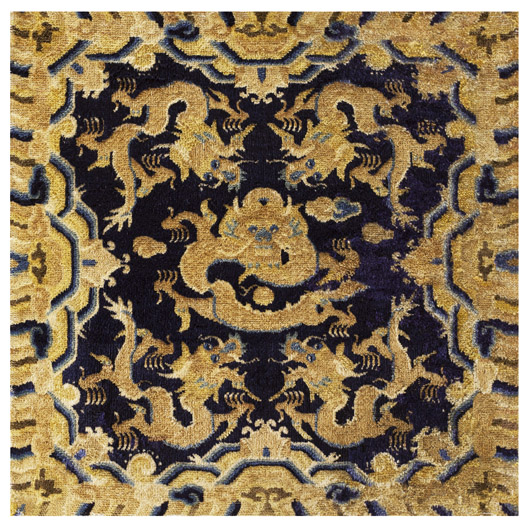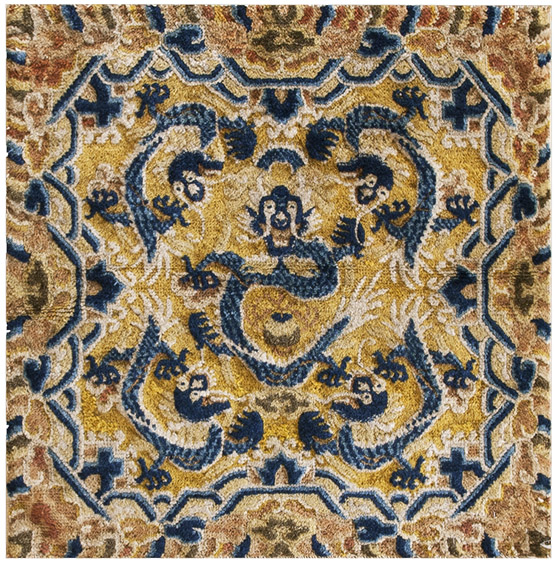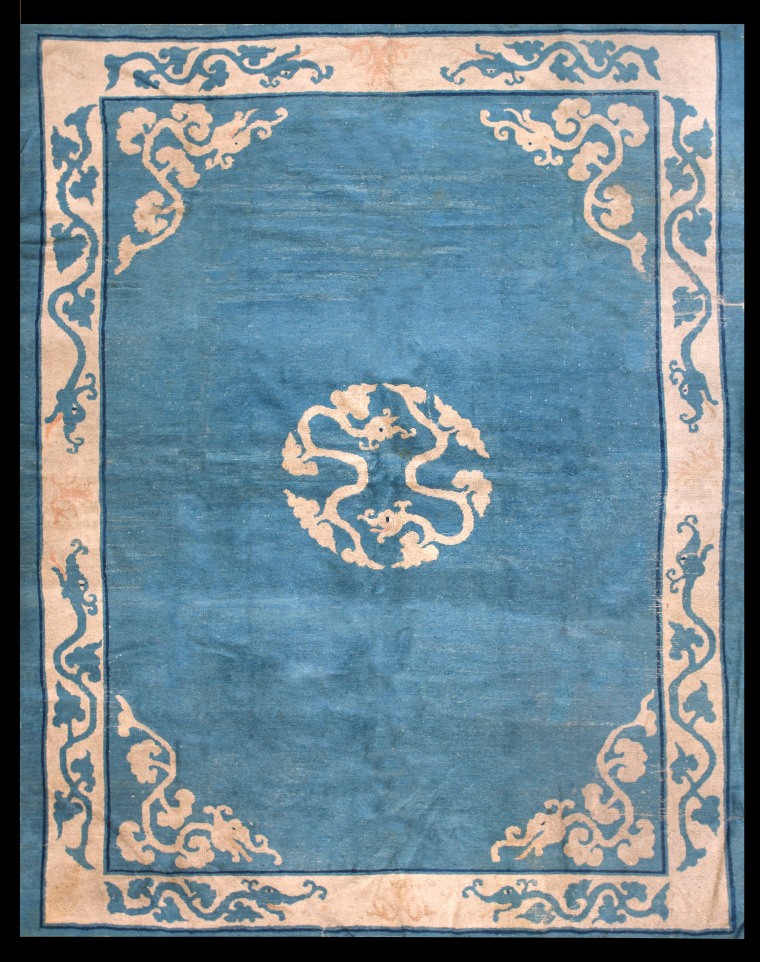The dragon is a mythical animal, but you’d never know it from looking at antique Peking Chinese carpets. The Chinese consider the dragon to be a composite of several actual animals: horse, snake, fish, etc. The phoenix, adapted from gold and silver pheasants, and the kylin, with ungulate hooves and flaming leg joints, are among the other popular mythical creatures appearing on Peking Chinese carpets. But the dragon is by far the most popular. Originally emblematic of the emperor and empire, the dragon came to symbolize anything Chinese. Put a proper style dragon on it, the Chinese reference is automatic. Hence a carpet with a dragon appears Chinese. The dragon(s) set the general tone of origin. The notion of the five-claws dragon being imperial and those with fewer having a lower status was, by the nineteenth century, ignored. Every dragon had five claws on each foot. Dragons appear on large carpets, small scatter rugs and chair furnishings. No listing can be complete, but our extensive collection of antique Peking Chinese rugs and carpets provides a uniquely broad conspectus of these dynamic animals.
The Chinese dragon is a benign beast, no matter how fierce it looks. Dwelling primarily in the clouds, it brings rain, so essential to what for millennia was a primarily agrarian economy.
The dragon appears on antique Peking imperial carpets made for the Forbidden City Palaces from at least the late 16th century. Although we do not have one of these, our no. 19737 is a close copy of an early 17th century carpet. The iconography has already been fixed: a full face central dragon, four corner dragons in profile, flaming pearls and clouds scattered about, waves and mountains for a border. The dragon is not intended to be goofy, but the weavers can’t help it.

The five dragon layout can be condensed to antique Chinese chair seat size as displayed on our nos. 22000 and 22074, the latter on a rare dark blue ground. These are Ningxia rather than Peking in origin, but they 8illustrated the basic design protocols. Blue and white is always a popular Chinese color scheme and dragons make it even more exotic, as on 22893.
22079

The central dragon may be embedded in a circular medallion while the four corner dragons writhe freely as in our nos. 22297 and 22576.
[illustrations of 22297 and 22576]
The full face central dragon may be replaced by a profile beast, as on our antique Peking carpet #23012 Chinese – Peking 8’0″ x 5’2″
Dragons may share the carpet with phoenixes or actual animals. A phoenix medallion and corner dragons is a popular field layout as on 40-2269. The entire gamut of twelve zodiacal animals may be dominated by a dragon, the only mythical beast, as on a blue and white antique Peking rug no. 22314
[illustrations of 40-2269, 22314]
The usual celestial dragon may be opposed by a rare terrestrial creature wrapped around a needle-like peak as on 22809 and 23144, both blue and white from the same shop and designer.
[illustrations of 22809 and 23144]
A veritable herd of dragons appears in the field and border of the antique Peking rug 22458 with composite foliage dragons in the medallion, corners and border, 14 in all

There are a few amusing dragon variants in Peking Chinese antique rugs that cannot escape notice. Three dimensional dragons wrap the border and extend into the field which is centred by a dragon and phoenix medallion in carpet no. 22921. A blue and white carpet (no. 22808) displays eight winged dragons, a Western rather than Chinese conceit.
[illustrations of 22921. 22808]

Finally, consider the small, almost secretive dragons as heads emerging from fretwork or vinery. This design convention goes back to at least Han dynasty times on bronzes and on rugs to the seventeenth century. A few examples on Peking antique carpets will suffice: 22837, 22942.
[illustrations of 22837, 22942.]
The dragon is a universal beast, but it first appears in Chinese art and any rug that prominently displays it is likely to be Chinese, most likely a Peking Chinese carpet of the 1880-1940 period. Our collection of these attractive and decorative carpets, so imaginatively rich, is the most comprehensive anywhere. Here there be dragons.
